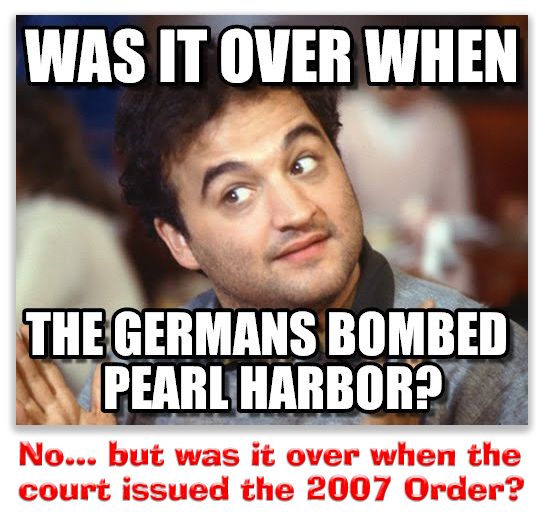We post news and comment on federal criminal justice issues, focused primarily on trial and post-conviction matters, legislative initiatives, and sentencing issues.

DON’T LOOK BACK
 Every so often, broadcast stations are required to air an announcement of their contest rules. This is because the FCC believes that listening to an avalanche of mumbo-jumbo delivered by the guy who used to do the Fedex fast-talking commercials makes us more informed listeners.
Every so often, broadcast stations are required to air an announcement of their contest rules. This is because the FCC believes that listening to an avalanche of mumbo-jumbo delivered by the guy who used to do the Fedex fast-talking commercials makes us more informed listeners.
We were reminded of one of the actually discernable phrases in the contest rules by today’s case: “Judges’ decisions are final.” Finality is a concept that seems hard for people to appreciate, but one which is necessary if the judicial system is every going to work.
 Normally, inmates are on the wrong side of this argument. A prisoner who believes she was wrongly convicted or sentenced wants to keep pleading the case until someone in authority finally agrees with her. There are exceptions to finality – new evidence that could not have been discovered before, a new court decision that meets requirements for being applied retroactively, even a retroactive change in the guidelines. But mostly, “final” means final.
Normally, inmates are on the wrong side of this argument. A prisoner who believes she was wrongly convicted or sentenced wants to keep pleading the case until someone in authority finally agrees with her. There are exceptions to finality – new evidence that could not have been discovered before, a new court decision that meets requirements for being applied retroactively, even a retroactive change in the guidelines. But mostly, “final” means final.
It today’s case, finality actually worked in favor of the defendant. Hakan Yalincak was an NYU student a decade ago when he pled guilty to running a sham hedge fund. Along with a sentence, the court in April 2007 imposed restitution of $4.2 million.
Hakan immediately applied under 18 USC 3664(j)(2) to have money recovered in the fund’s bankruptcy be credited to his restitution. The government paid little attention to the request, noting only that it had no objection to grant of Hakan’s motion. The district court thus approved the request, ultimately applying about $1.55 million collected by the bankruptcy trustee to the amount Hakan was to pay.
 What no one appreciated was that the federal bankruptcy system works in a way that would a mere amateur fraudster like Hakan blush. Sure the trustee collected $1.55 million, but by the time all of the bankruptcy vultures – lawyers, trustees, experts – got done picking at it, the victims of the scam got about $300,000. In May 2015, the district court realized that the amount of money actually reaching the victims was about 20% of the credit it had given Hakan, it vacated the 2007 order under F.R.Civ.P. 60(a), which gives a court the power to “correct a clerical mistake or a mistake arising from oversight or omission whenever one is found in a judgment.”
What no one appreciated was that the federal bankruptcy system works in a way that would a mere amateur fraudster like Hakan blush. Sure the trustee collected $1.55 million, but by the time all of the bankruptcy vultures – lawyers, trustees, experts – got done picking at it, the victims of the scam got about $300,000. In May 2015, the district court realized that the amount of money actually reaching the victims was about 20% of the credit it had given Hakan, it vacated the 2007 order under F.R.Civ.P. 60(a), which gives a court the power to “correct a clerical mistake or a mistake arising from oversight or omission whenever one is found in a judgment.”
Hakan appealed, arguing the 2007 order was final and could not be disturbed.
This week, the 2nd Circuit Court of Appeals agreed with Hakan. The Court said the issue turned on whether an order modifying restitution was a final, appealable order. If so, the district court could not later revisit it. If not, the order remained open to modification by the district court.
The Circuit decided the 2007 order was final:
When the district court granted Yalincak’s motion for credit, it made a conclusive determination as to Yalincak’s entitlement to credit… The order did not dispose of the issue of restitution entirely, given that the credits were not enough to discharge Yalincak’s restitution obligations in full and thereby end the restitution proceedings. Nonetheless, the district court’s resolution of the § 3664(j)(2) motion was a final decision as to Yalincak’s claim regarding the proper accounting for particular funds. If such a decision were not considered final and appeal had to wait until Yalincak had discharged his restitution obligations entirely, it is unclear as a practical matter whether the district court’s grant of the Sec 3664(j(2) motion could ever be challenged.
 Yalincak still owed close to $2 million, according to the district court’s calculations. The Circuit admitted that “the district court’s desire to correct an error largely attributable to the government’s somewhat casual consent is understandable. Nevertheless, considerations of finality dictate that by the time the error was noticed, it was beyond the power of the court to correct.”
Yalincak still owed close to $2 million, according to the district court’s calculations. The Circuit admitted that “the district court’s desire to correct an error largely attributable to the government’s somewhat casual consent is understandable. Nevertheless, considerations of finality dictate that by the time the error was noticed, it was beyond the power of the court to correct.”
United States v. Yalincak, Case No. 11-5446 (2nd Cir., April 10, 2010)
– Thomas L. Root

